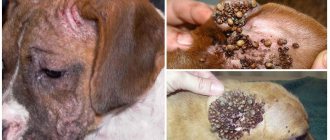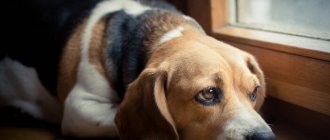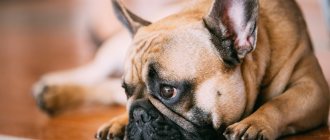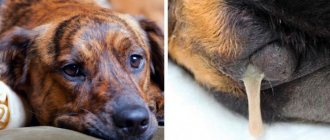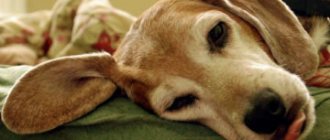Lifestyle after recovery
A dog after enteritis is usually very emaciated and weakened. Even when the realization comes that the disease does not control the animal, it is too early to rejoice! Against the background of the withdrawal of certain medications, various strengthening and vitamin preparations will be prescribed, which will have to be taken either until the condition is completely normalized, or for life.
First of all, you need to pay attention to nutrition - while taking restorative medications for a puppy after enteritis, it is important to drink a lot. Introduce food gradually and starting with a liquid consistency.
For dysbiosis, which necessarily accompanies the recovery period after taking loading doses of antimicrobial agents, probiotics are prescribed.
After an illness, a dog definitely needs to walk in the fresh air - on its own or in your arms, it doesn’t matter. Physical exercise is welcome, but not to the point of exhaustion - run moderately, play moderately.
Subsequent vaccinations should be carried out only after the animal has fully recovered with the preliminary administration of prophylactic serum. Enteritis very often occurs after vaccination due to the weakness of the immune system and widespread mutation of the viruses of this disease.
Basic restorative drugs:
Enervite (Enervita)
High-calorie energy paste for puppies and adult dogs that stimulates appetite and improves overall health. Has a positive effect on the condition of the coat and skin, has no contraindications (cost: 60-85 rubles)
Dose: 1.5 teaspoons/4.5 kg of animal weight during recovery and 3 teaspoons/4.5 kg during illness. It is better to give before meals.
Vetom 1.1.
Antiviral, anti-disbacteriotic and restorative drug used during the recovery period after various diseases. It has no contraindications or side effects (cost: 150-170 rubles).
Dose: 50 mg powder/kg body weight once a day for up to 3 weeks daily. During illness, the dosage can be doubled, given in two doses. Rectal administration using a syringe is allowed. The powder is dissolved in water or mixed with warm food.
Bifitrilak
A complex preparation consisting of an adsorbent and a probiotic. It copes well with dysbiosis, especially after viral and bacterial infections. No side effects or contraindications (cost: 25-40 rub./5 g).
Dose: 1/3 teaspoon per animal with food. Once a day for a therapeutic course of 10-14 days, a preventive course for 3-5 days.
Lactoferon
A drug containing interferons and eubiotic bacteria. Increases the body's resistance to viruses and normalizes digestion. There are no contraindications (cost: 45-60 rub./20 tablets).
Dose: 1 tablet/10 kg total weight for large dogs and 1 tablet. puppies. Course: 1-2 times a day for 5-12 days.
Aminovit
Vitamin-amino acid complex for recovery from illnesses, better weight gain after exhaustion. It has no side effects or contraindications (cost: 80-100 rubles/1 amp.).
Dose: weight up to 5 kg – 1-1.5 ml intramuscularly; up to 20 kg – 3 ml. Course: twice a week for a month and a half.
Treatment of enteritis in a puppy
At the first symptoms of enteritis, a person must immediately contact a veterinarian to have the puppy tested and make a correct diagnosis. If the puppy is weakened, it is better to call a veterinarian at home.
If the puppy is not vomiting, you should give him plenty of food tablets and activated carbon tablets (1 tablet per 1 kg of body weight). Other medications should not be given unless prescribed by a veterinarian.
In case of diarrhea, in order to avoid complete dehydration, the puppy should be given the following liquid: 1 liter of water, 3.5 g of salt, 2.5 g of soda, 1.5 g of potassium chloride, 20 g of sugar. Prepare the mixture at the rate of 40 ml of the prepared solution per 1 kg of body weight.
Upon arrival, the veterinarian will prescribe antibiotics for the puppy in combination with antiviral drugs and medications that increase immunity.
Feeding a dog after enteritis
The most important consequence of enteritis is long-term disruption of the gastrointestinal tract. After the illness, when the vomiting has been eliminated and the dog’s condition is stable, you can begin to feed it.
Important: you cannot force feed an animal that has recovered from enteritis! The beginning of feeding should coincide with the dog’s natural state of hunger and the desire to eat itself!
General recommendations for restorative feeding:
- Diet after enteritis is mandatory!
- You need to start feeding with great caution. Almost the entire gastrointestinal system after enteritis is a continuous or incompletely healed wound surface. Any rough food will cause pain and discomfort. Also, hard and rough food will not be digested at all.
- Meals should be dietary, fractional, frequent and nutritious. You can make up the diet yourself, or you can choose ready-made industrial feed (not dry!).
- All food should be at a comfortable temperature, always fresh and chopped - the smaller the animal that has been ill, the smaller the food should be. It is recommended to prepare food before each meal.
- Frequent and divided feedings should continue for up to 3-4 weeks. Only after this period of time can you transfer your pet to a normal diet.
- Considering the individual consequences after viral enteritis, it is possible that dietary nutrition will accompany the dog throughout its life.
You can and should:
- eliminate or reduce the amount of carbohydrate food consumption;
- introduce fermented milk foods into the diet, excluding whole milk (kefirs, cottage cheese, yogurt);
- vegetable or weak and low-fat chicken broths;
- after the broths, you can add boiled vegetables and slimy porridges cooked in water;
- the meat is introduced last, boiled and always chopped; It is better to mix with vegetables or cereals.
Absolutely forbidden:
- overfeed;
- add seasonings and spices to food;
- give sausage;
- feed with sweet and starchy foods;
- feed with bones;
- introduce any fatty foods into your diet, including fatty meat and fish.
Quarantine
After a dog becomes ill, the enteritis virus can circulate in the environment for up to six months (according to some sources, up to one year). This must be taken into account if the animal died and the decision was made to get a new pet.
Before getting a new pet, you should consider:
- age (it is better not to take puppies at risk age – up to 6-10 months);
- quarantine time (during the quarantine period it is better not to get new dogs);
- The new dog must have vaccinations (must be).
During the quarantine period, it is recommended to disinfect premises where a sick or dead dog was located. It should be taken into account that the treatment of premises and care items does not shorten the quarantine period.
Disinfection of premises after a viral infection
Before bringing a new puppy into a house where there was an animal with enteritis, it is necessary to carry out a number of disinfecting measures.
The enteric virus is quite resistant to various environmental conditions - pH (acidity) and temperature fluctuations (a temperature of 80°C kills the virus only after 15 minutes). However, direct sunlight inactivates the pathogen quickly enough. The virus does not respond to trypsin, fat-soluble substances and many disinfectants.
After recovery or death of an animal from viral enteritis, it is necessary to:
- Get rid of absolutely all things that belonged to a dog that died of enteritis or that were used by a sick animal. It is allowed to leave what can be boiled.
- Absolutely all items are washed at a temperature of 70-80°C or boiled. After washing, iron on both sides or steam. It is recommended to repeat this procedure after 1.5-2 weeks.
- Furniture and carpets are cleaned with a steam cleaner and also sprayed with a disinfectant.
- It is recommended to treat walls, ceilings, windows and doors - spray with disinfectant solutions.
- Quartz treatment gives a good result (it is important that the lamp is within its expiration date). When treating with quartz, all living things are removed from the room, including flowers, and after the procedure everything is well ventilated.
It would be good to repeat all procedures after 1.5-2 weeks and in all respects - only in this case will disinfection after enteritis make sense. This is especially important if the dog died from enteritis, and you plan to adopt a new puppy.
The most commonly used disinfectants for home disinfection
All treatments are recommended to be carried out without the presence of people and animals. In addition to the commonly available chlorine-containing cleaning products: Comet, Luxus, Bianol, Domestos or Bleach, the following can be used:
In what cases does a patient need urgent hospitalization?
In case of severe enteritis, hospital treatment is required under the supervision of qualified doctors and nurses.
The main reasons for hospitalization are the following:
- Heat.
- Repeated and constant vomiting.
- Acute and unbearable pain in the abdomen, accompanied by pale skin.
- Loss of consciousness from severe pain or dehydration.
In this case, treatment is aimed at immediately eliminating intoxication and stabilizing the water-salt balance.
What is enteritis, its features and types of disease
Enteritis is a pathology of a viral nature, caused by the reproduction and vital activity in the dog’s body of pathogens of three groups: parvoviruses, coronaviruses, rotaviruses.
Penetrating into the digestive tract, bacteria begin to actively multiply, the animal’s immune system begins to respond, but a sufficient amount of antibodies for recovery is produced only by the fifth day of the disease. By this time, pathological processes can lead to irreversible consequences.
Microorganisms provoke an inflammatory process in the gastrointestinal tract (usually in the small intestine). As a result, the mucous membrane of the affected organ is destroyed, swelling is formed, the process of food digestion is disrupted, and the dog’s cells do not receive the necessary nutrients.
If the disease is protracted, the impact of the virus extends to:
- liver;
- heart;
- pancreas;
- kidneys, other organs.
The most dangerous type of infection for dogs is considered to be parvovirus (mortality is up to 85% of infected dogs). The other two varieties lead to the death of the animal less frequently (5–10%), but can lead to the development of secondary pathologies and cause serious complications.
Non-viral enteritis
Most forms of the disease are caused by viruses, but sometimes a non-infectious variety of the disease is diagnosed.
In this case, intestinal inflammation is caused by:
- poor nutrition;
- poisoning;
- burns and other damage to the mucous membranes of the digestive organs.
The disease develops in the same way as with a viral infection.
Parvovirus enteritis
This form is considered the most dangerous and is produced by damaging the intestinal mucosa over a wide area. Without treatment, the membranes are completely destroyed, rejected, and excreted in feces and vomit.
Parvovirus enteritis exists in three varieties:
- intestinal;
- myocardial. Puppies under nine weeks of age are more susceptible to it. Most individuals die; those who survive acquire chronic pathologies of the cardiovascular system;
- mixed. In this form, the destructive effect of the virus spreads simultaneously to the digestive organs and the myocardium.
In 80% of cases of enteritis in dogs, the intestinal type of disease is diagnosed, in 20% - cardiac. The combined form usually affects weakened animals, puppies from litters from unvaccinated bitches, dogs with concomitant infectious diseases (for example, adeno- or rotavirus).
Coronavirus enteritis
This form of pathology occurs in the mildest form; the microorganism damages only the tips of the intestinal villi. This leaves a good chance for the dog to fully recover. Only initially weak individuals die (both adults and young animals).
The infection can occur in two forms:
- light, which often goes unnoticed by the pet. Owners consider it to be a slight stomach upset. Goes away on its own after using sorbents;
- The acute variety is characterized by rapid development and a high probability of secondary infection.
Coronavirus enteritis itself does not cause inflammation of the intestines
Consequences of enteritis
Most people who are faced with the need to save their pet, even if the therapy was successful, note a significant deterioration in the pet’s health. After enteritis, which occurs in the intestinal version, the animal exhibits symptoms of dysfunction of the gastrointestinal tract. To restore the body, the pet requires a special diet. The dog's diet should include liquid food, for example, low-fat broths, cottage cheese diluted with water or porridge. After enteritis, you can give your pet special veterinary food. You need to give food in small portions 5-6 times a day. Food should be at room temperature.
Among other things, after enteritis, even with proper treatment, the animal can develop severe complications. Puppies who have suffered this pathological condition often develop lameness later on. In some cases, with proper therapy, it goes away after just 2-3 months, but sometimes it remains forever. If the heart was affected during the course of the disease, after enteritis the animal may lag behind in development. In addition, in adulthood, the animal may develop failure due to residual myocardial damage. Rare complications observed after enteritis include disorders of the liver and gallbladder. In addition, the bitch after this infectious disease may become infertile.
In most cases, if the animal was able to survive enteritis, all residual effects disappear within the first six months.
Dogs that have recovered from this infectious disease develop strong immunity. Thus, subsequently the risk of re-infection with viruses that cause enteritis is minimal.
